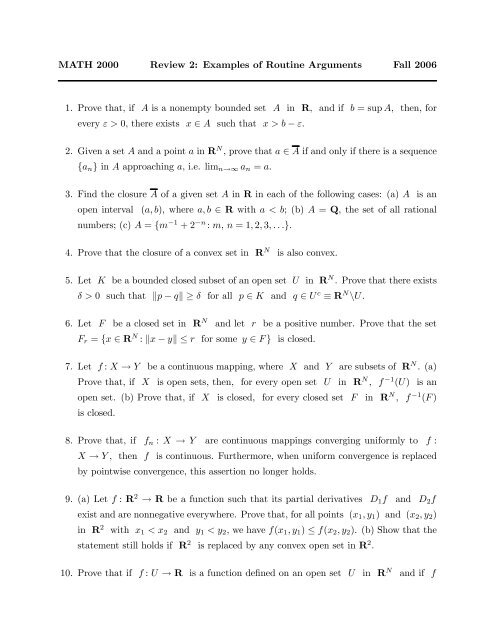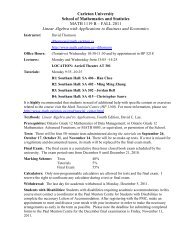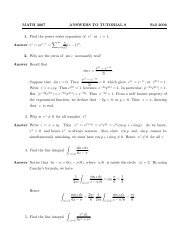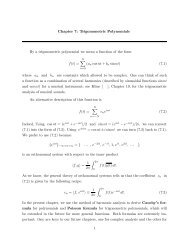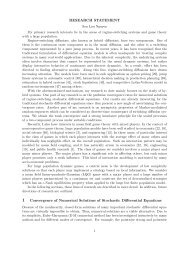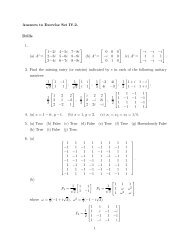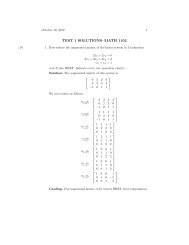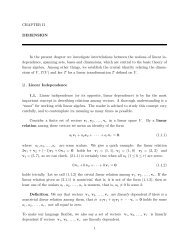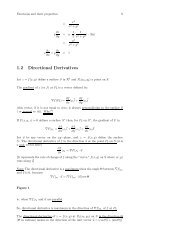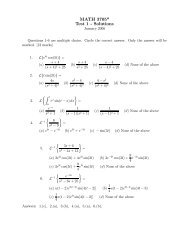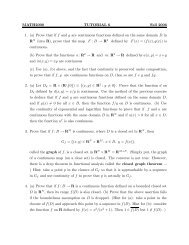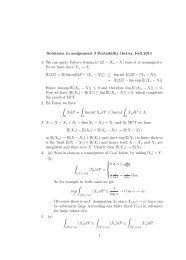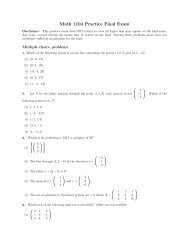MATH 2000 Review 2: Examples of Routine Arguments Fall 2006 1 ...
MATH 2000 Review 2: Examples of Routine Arguments Fall 2006 1 ...
MATH 2000 Review 2: Examples of Routine Arguments Fall 2006 1 ...
Create successful ePaper yourself
Turn your PDF publications into a flip-book with our unique Google optimized e-Paper software.
<strong>MATH</strong> <strong>2000</strong> <strong>Review</strong> 2: <strong>Examples</strong> <strong>of</strong> <strong>Routine</strong> <strong>Arguments</strong> <strong>Fall</strong> <strong>2006</strong><br />
1. Prove that, if A is a nonempty bounded set A in R, and if b = sup A, then, for<br />
every ε > 0, there exists x ∈ A such that x > b − ε.<br />
2. Given a set A and a point a in R N , prove that a ∈ A if and only if there is a sequence<br />
{an} in A approaching a, i.e. limn→ ∞ an = a.<br />
3. Find the closure A <strong>of</strong> a given set A in R in each <strong>of</strong> the following cases: (a) A is an<br />
open interval (a, b), where a, b ∈ R with a < b; (b) A = Q, the set <strong>of</strong> all rational<br />
numbers; (c) A = {m −1 + 2 −n : m, n = 1, 2, 3, . . .}.<br />
4. Prove that the closure <strong>of</strong> a convex set in R N is also convex.<br />
5. Let K be a bounded closed subset <strong>of</strong> an open set U in R N . Prove that there exists<br />
δ > 0 such that p − q ≥ δ for all p ∈ K and q ∈ U c ≡ R N \U.<br />
6. Let F be a closed set in R N and let r be a positive number. Prove that the set<br />
Fr = {x ∈ R N : x − y ≤ r for some y ∈ F } is closed.<br />
7. Let f : X → Y be a continuous mapping, where X and Y are subsets <strong>of</strong> R N . (a)<br />
Prove that, if X is open sets, then, for every open set U in R N , f −1 (U) is an<br />
open set. (b) Prove that, if X is closed, for every closed set F in R N , f −1 (F )<br />
is closed.<br />
8. Prove that, if fn : X → Y are continuous mappings converging uniformly to f :<br />
X → Y , then f is continuous. Furthermore, when uniform convergence is replaced<br />
by pointwise convergence, this assertion no longer holds.<br />
9. (a) Let f : R 2 → R be a function such that its partial derivatives D1f and D2f<br />
exist and are nonnegative everywhere. Prove that, for all points (x1, y1) and (x2, y2)<br />
in R 2 with x1 < x2 and y1 < y2, we have f(x1, y1) ≤ f(x2, y2). (b) Show that the<br />
statement still holds if R 2 is replaced by any convex open set in R 2 .<br />
10. Prove that if f : U → R is a function defined on an open set U in R N and if f
is differentiable at a point x0 in U, then the directional derivative<br />
f(x0 + tv) − f(x0)<br />
Dvf(x0) = lim<br />
t→ 0 t<br />
exists and is equal to Df(x0)v for each v ∈ R N .<br />
11. Prove the product rule for functions <strong>of</strong> several variables: if f and g be differentiable<br />
functions on an open set U in R N , then their product fg is also differentiable and<br />
D(fg)(x) = f(x)Dg(x) + g(x)Df(x) for all x ∈ U. Recall: the differentiability <strong>of</strong><br />
f with the linear map Df(x) as its derivative means that for all x ∈ U we can<br />
write f(x + h) − f(x) = Df(x)h + R(x, h) where limh→ 0 R(x, h)/h = 0.<br />
Answers<br />
1. By definition, b is the least upper bound <strong>of</strong> A. For any ε > 0, we have b − ε < b<br />
and hence b − ε is not an upper bound <strong>of</strong> A, meaning that there is some x ∈ A<br />
such that x > b − ε.<br />
2. Suppose that a ∈ A. Then, for each positive integer n, we have B 1/n(a) ∩ A = ∅.<br />
Take any an ∈ B 1/n(a) ∩ A. Then {an} is a sequence in A approaching a. Conversely,<br />
suppose that there is a sequence {an} in A approaching a. Then, for any ε > 0,<br />
there exists some n such that an − a < ε and hence an ∈ Bε(a) ∩ A, showing that<br />
Bε(a) ∩ A is nonempty.<br />
3. (a) (a, b) = [a, b]; (b) Q = R;<br />
(c) A = {0} ∪ {m −1 : m = 1, 2, . . .} ∪ {m −1 + 2 −n : m, n = 1, 2, 3, . . .}.<br />
4. Let A be a convex set in R N and let a, b ∈ A. Then there are sequences {an} and<br />
{bn} in A converging to a and b respectively. We need to prove that, for each<br />
t ∈ [0, 1], (1 − t)a + tb ∈ A. Since A is convex and since an and bn are in A, we<br />
have (1 − t)an + tbn ∈ A. Now {(1 − t)an + tbn} is a sequence in A converging to<br />
(1 − t)a + tb. Hence (1 − t)a + tb ∈ A.
5. Suppose the contrary that such δ > 0 does not exist. Then, for each positive integer<br />
n, there exists pn ∈ K and qn ∈ U c such that pn − qn < 1/n. Since {pn}<br />
is a sequence in a bounded closed set K, by Bolzano-Weierstrass theorem, it has a<br />
subsequence, say {pnk}, converging to some p in K. From pn − qn < 1/n we<br />
see that {qnk } also converges to p as well. Since qnk are in the closed set U c , we<br />
deduce that the limit p is also in U c . Thus p is in both K and U c , contradicting<br />
the fact that K and U c do not intersect.<br />
6. Let {xn} be a sequence in Fr converges to some point x. It is enough to show<br />
that x ∈ Fr. By assumption, for each n, there exists some yn ∈ F such that<br />
xn − yn ≤ r. Let zn = xn − yn. Then zn ≤ r for all n and hence {zn} is<br />
a bounded sequence. By Bolzano–Weierstrass theorem, we can extract a convergent<br />
subsequence <strong>of</strong> {zn}, say {znk } with limk→ ∞ znk = z. Since znk ≤ r for all k,<br />
we have z ≤ r as well. Now ynk = xnk − znk converges to x − z ≡ y as k → ∞.<br />
Since ynk ∈ F and since F is closed, we have y ∈ F . Thus we have y ∈ F and<br />
x − y = z ≤ r, showing that x ∈ Fr.<br />
7. (a) Take any point x0 ∈ f −1 (U). We are going to show that there exists δ > 0 such<br />
that Bδ(x0) ⊆ f −1 (U). Now x0 ∈ f −1 (U) means f(x0) ∈ U. Since U is open, there<br />
exists ε > 0 such that Bε(f(x0)) ⊆ U. Since f is continuous at x0, there exists<br />
δ0 > 0 such that f(Bδ0 (x0) ∩ X) ⊆ Bε(f(x0)). In particular, f(Bδ0 (x0) ∩ X) ⊆ U.<br />
Since X is open, there exists δ1 > 0 such that Bδ1 (x0) ⊆ X. Let δ = min{δ0, δ1}.<br />
Then Bδ(x0) ⊆ Bδ0 (x0) ∩ X and hence f(Bδ(x0)) ⊆ U. The last inclusion can be<br />
rewritten as Bδ(x0) ⊆ f −1 (U). This shows that U is open.<br />
(b) It is enough to show that a point x0 in f −1 (F ) is in fact in f −1 (F ). Notice<br />
that since X is closed and since f −1 (F ) ⊆ X, we have f −1 (F ) ⊆ X. Hence<br />
x0 ∈ X and thus f(x0) is defined. Take any sequence {xn} in f −1 (F ) converging<br />
to x0; (this is possible since x0 is in the closure <strong>of</strong> f −1 (F )). Then f(xn) ∈ F for<br />
all n. By the continuity <strong>of</strong> f, {f(xn)} converges to f(x0). Since F is closed, we<br />
have f(x0) ∈ F and consequently x0 ∈ f −1 (F ).<br />
8. Take any point x0 ∈ K. We are going to prove that f is continuous at x0. Let ε > 0<br />
be given. Since {fn} converges to f on K uniformly, there exists some N such that<br />
|fN(x) − f(x)| < ε/3 for all x ∈ K. Since fN is continuous, there exists δ > 0 such
that |fN(x) − f(x0)| < ε/3 for all x ∈ K ∩ Bδ(x0). Hence, for all x ∈ K ∩ Bδ(x0),<br />
|f(x) − f(x0)| = |f(x) − fN (x) + fN(x) − fN (x0) + fN (x0) − f(x0)|<br />
≤ |f(x) − fN (x)| + |fN (x) − fN (x0)| + |fN (x0) − f(x0)|<br />
≤ ε/3 + ε/3 + ε/3 = ε.<br />
Hence f is continuous at x0. To show that the assumption <strong>of</strong> uniform convergence is<br />
essential, let us entertain the following example. Define a sequence <strong>of</strong> functions {fn}<br />
on [0, 1] by putting fn(x) = x n . Then limn→ ∞ fn(x) = f(x) for all x ∈ [0, 1],<br />
where<br />
f(x) =<br />
Clearly f is discontinuous at 1.<br />
0 if 0 ≤ x < 1;<br />
1 if x = 1.<br />
9. (a) Given points (x1, y1) and (x2, y2) in R 2 with x1 < x2 and y1 < y2, consider<br />
the functions f1 and f2 on R given by f1(x) = f(x, y1) and f2(y) = f(x2, y).<br />
The mean value theorem tells us that f1(x2) − f1(x1) = f ′ 1(ξ)(x2 − x1) for some ξ ∈<br />
[x1, x2]. The last identity can be rewritten as f(x2, y1) − f(x1, y1) = D1f(ξ, y1)(x2 −<br />
x1). Since D1f ≥ 0 and x2 > x1, we have f(x2, y1) ≥ f(x1, y1). Similarly we have<br />
f2(y2) − f2(y1) = f ′ 2 (η)(y2 − y1) for some η ∈ [y1, y2], or f(x2, y2) − f(x2, y1) =<br />
D2f(x2, η)(y2−y1), from which we obtain f(x2, y2) ≥ f(x2, y1) by noticing D2f ≥ 0.<br />
Thus we have f(x2, y2) ≥ f(x2, y1) ≥ f(x1, y1).<br />
10. Write f(x0 + h) = f(x0) + Df(x0)h + R(x0; h). Let ε > 0 be given. By assumption,<br />
there exists δ > 0 such that |R(x0; h)|/h ≤ ε (or |R(x0, h)| ≤ εh) for all<br />
h with h < δ. Let η = δ/v if v = 0 and η = 1 otherwise. Then, when<br />
0 < |t| < η, we have |tv| < δ and hence<br />
<br />
f(x0<br />
<br />
+ tv) − f(x0)<br />
t<br />
<br />
<br />
− Df(x0)v <br />
=<br />
<br />
<br />
f(x0<br />
<br />
+ tv) − f(x0) − Df(x0)tv <br />
<br />
<br />
t<br />
<br />
<br />
<br />
= <br />
R(x0; tv) <br />
<br />
t ≤ εtv = εv.<br />
|t|<br />
This shows that the directional derivative Dvf(x0) exists and is equal to Df(x0)v.<br />
11. By assumption, at each point x ∈ U, we have<br />
f(x + h) − f(x) = Df(x)h + Rf(x, h), g(x + h) − g(x) = Dg(x)h + Rg(x, h)
with limh→ 0 Rf(x, h)/h = 0 and limh→ 0 Rg(x, h)/h = 0. Hence<br />
f(x + h)g(x + h) − f(x)g(x)<br />
= f(x + h)g(x + h) − f(x)g(x + h) + f(x)g(x + h) − f(x)g(x)<br />
= g(x + h)(Df(x)h + Rf (x, h)) + f(x)(Dg(x)h + Rg(x, h))<br />
= g(x)Df(x)h + (g(x + h) − g(x))Df(x)h + Rf (x, h)g(x + h)<br />
+ f(x)Dg(x)h + f(x)Rg(x, h)<br />
= (f(x)Dg(x) + g(x)Df(x))h + R(x, h),<br />
where R(x, h) = (g(x + h) − g(x))Df(x)h + Rf (x, h)g(x + h) + f(x)Rg(x, h) satisfies<br />
|R(x, h)|<br />
h ≤ |g(x + h) − g(x)| Df(x) + |Rf(x, h)|<br />
g(x + h) + |f(x)|<br />
h<br />
|Rg(x, h)|<br />
h<br />
which converges to 0 as h → 0.


